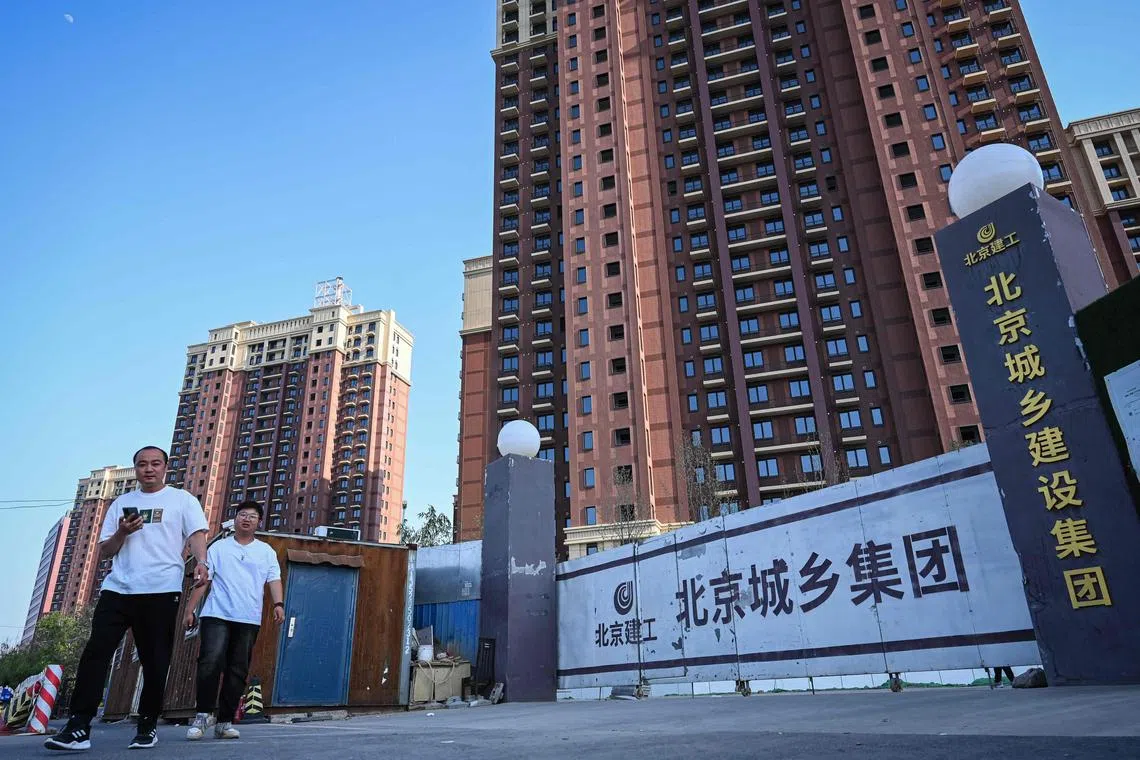China’s housing rescue package too small to end crisis, analysts say
Sign up now: Get ST's newsletters delivered to your inbox

The decline in China’s sales of new homes has accelerated in recent months, with households increasingly preferring to buy in the secondary market.
PHOTO: AFP
Follow topic:
HONG KONG – China’s latest housing initiative is aimed at vacant properties, a major pain point in a crisis that has dragged on for almost three years. But the package of measures is still too small to end the rout, analysts say.
The decline in China’s sales of new homes has accelerated in recent months, with households increasingly preferring to buy in the secondary market. This has pushed up the stock of unsold homes and empty land to the highest level in years, discouraging new construction and threatening more defaults by developers – including large state-owned firms.
The support package announced on May 17 features a 300 billion yuan (S$56 billion) facility from the People’s Bank of China (PBOC) that will fund bank loans for the state companies charged with buying up completed but unsold housing stock.
Economists expressed concern both about the limited size of the measure relative to the stock of unsold housing and the risk it will not be fully implemented.
Officials said the central bank programme can incentivise bank loans worth 500 billion yuan. This would address only a fraction of the value of vacant apartments in China, which economists estimate at multiple trillions of yuan.
“Any game-changing housing easing measures (including those for housing destocking) would likely require significantly more funding than available thus far,” Goldman Sachs economists wrote in a note, citing earlier research that getting outstanding housing inventory back to 2018 levels would require 7.7 trillion yuan.
Property shares gave up earlier intraday gains on May 20, with the CSI real estate sub-index closing 1.23 per cent lower, as investors took profit and caution emerged about whether the measures were enough to tame the property crisis.
This stood in contrast to positive coverage in Chinese state media on May 20. The Securities Times reported that Chinese developers’ sales centres in more than 10 cities, including Beijing and Shanghai, saw a surge of visits by homebuyers over the weekend.
President Xi Jinping’s economy czar has backed the high-profile programme, which gives local governments the responsibility to turn previously unsold apartments into affordable housing.
The real estate sector has become the biggest drag on the world’s second-largest economy, weighing heavily on sentiment and consumer spending.
Doubts still remain as to whether banks will make full use of the new facility. Commercial lenders’ involvement will “limit the speed and efficacy of fund deployment”, said Mr Rory Green, chief China economist at TS Lombard.
A previous PBOC lending programme for commercial banks aimed at rental housing projects saw a low level of take-up, with just 2 per cent of the funds having been utilised.
The new destocking initiative has already been trialled in eight cities, and worked best in areas with population inflows – a condition not met by all metropolises.
A programme encouraging local governments to buy unused land from developers also faces challenges. Many regions are fiscally strained, and officials at a briefing on May 17 warned that such efforts should not increase local government debt risks.
The regional authorities will be allowed to use some of their annual 3.9 trillion yuan bond borrowing quota for the new initiative, but much of that has already been earmarked for infrastructure projects.
It is unclear if local governments will be willing to pay “anything close to what the developer paid” for land, said Mr Adam Wolfe, emerging markets economist at Absolute Strategy Research.
“If developers have to recognise a loss on their land banks, then they might have to recognise some solvency problems, not just cash flow issues.”
To boost bank lending to developers to ensure they finish existing projects, officials are doubling down on a so-called “white list” effort that identifies developments meriting support.
This plan, introduced in January, has seen approved lending reach more than 900 billion yuan, according to officials.
But the funds do not seem to be reaching property companies, which raised less than 600 billion yuan in loans for construction projects in the first four months of 2024, according to the country’s statistics bureau. This is down 9 per cent from a year earlier.
The white list programme is limited by the incentives of commercial banks, which worry about developer defaults impacting their bottom line. The same issue applies to new measures that allow banks to lower mortgage rates and down-payment requirements.
Lenders have already lowered mortgage rates to historic lows, and could be reluctant to make further cuts.
Households might also use lower rates to buy existing properties rather than newly built ones, as those prices have fallen further and delivery is not a concern.
China’s existing home sales overtook those of new homes by area for the first time on record in 2023, underscoring a fundamental shift in buying habits that means less cash for developers.
Cutting mortgage rates to stimulate sales may work in larger cities with more housing demand, but not in smaller ones where rates have already been cut to the bone, said Mr Song Houze, an economist at the Paulson Institute, a US think-tank.
“The new policies may stimulate property sales for a couple of months,” he added. “But I doubt they are sufficient to reverse the tide.” BLOOMBERG

